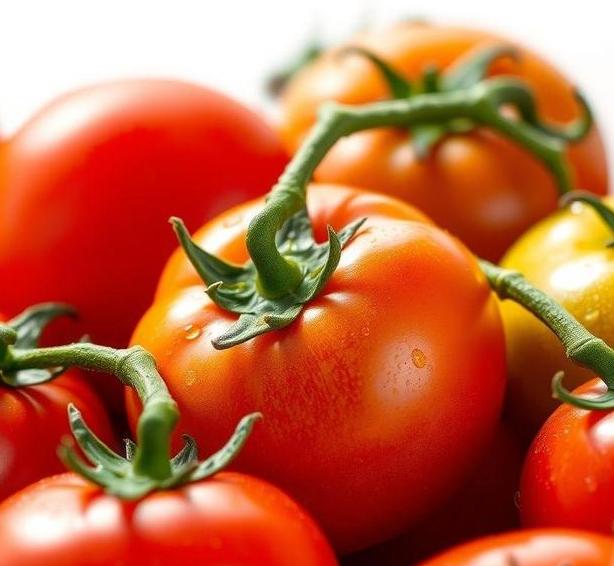Can Tomatoes Go Bad : What You MUST Know
Tomatoes are a staple in many households, loved for their versatility in cooking, vibrant color, and refreshing taste. Whether you’re chopping them into a salad, making a tangy marinara sauce, or simply enjoying them in a sandwich, tomatoes are often present in our kitchens. But, like any fresh produce, tomatoes can spoil over time. However, how can you tell when they’re past their prime? And what are the best ways to preserve them?
This guide dives into the details of tomato spoilage, how to properly store them, and expert tips for extending their shelf life. By the end, you’ll be equipped with all the information needed to make the most of your tomatoes, ensuring you avoid unnecessary waste and enjoy them at their best.
Can Tomatoes Go Bad?
Yes, tomatoes can absolutely go bad! While they’re a durable fruit when handled and stored properly, they do have a limited shelf life. Unlike some vegetables or fruits that can withstand extended periods of time without noticeable deterioration, tomatoes are fairly perishable. Factors like temperature, humidity, exposure to air, and how ripe they are at the time of purchase can all affect how long they last.
Tomatoes are also highly sensitive to certain environmental factors. For example, they tend to spoil faster if they are exposed to extreme temperatures or moisture. It’s crucial to understand the factors at play to maximize their freshness and flavor.
Shelf Life For Tomatoes

The shelf life of a tomato can vary based on its ripeness when you purchase it and how it’s stored. Here’s a detailed breakdown:
-
Fresh, Ripe Tomatoes
- Room temperature: They typically last 3 to 5 days when kept at room temperature. They continue to ripen over time, and once fully ripe, they can spoil faster.
- Refrigeration: Although refrigeration can extend the shelf life of tomatoes for a few extra days (about 1 week), it can also negatively affect their taste and texture, often resulting in a mealy or mushy consistency.
-
Unripe Tomatoes
- Room temperature: Unripe tomatoes can be stored for about 1 to 2 weeks at room temperature until they ripen. If you leave them too long, they may start to soften or even rot.
- Refrigeration: If you’re not in a rush to use them, you can place unripe tomatoes in the fridge, but remember to allow them to ripen at room temperature before eating to maintain their flavor and texture.
-
Canned Or Preserved Tomatoes
- If you’ve bought canned or jarred tomatoes, they can last for up to 1 to 2 years when stored in a cool, dry place. Once opened, they should be used within 5 to 7 days and refrigerated.
Common Signs Of Spoilage
Spotting spoiled tomatoes early can save you from consuming bad produce or, even worse, having to throw away food that could have been saved. Here are some signs to look out for:
- Color Changes: A tomato’s vibrant red, yellow, or orange color is one of its most attractive features. When tomatoes start turning an off-color, like greenish or dark brown spots, it’s a sign that they’re overripe or starting to decay.
- Softness and Mushiness: Fresh tomatoes should feel firm with a slight give when you press them. If they’re overly soft, squishy, or have indentations that don’t spring back, it likely means they’ve passed their peak and may be heading toward spoilage.
- Wrinkled Skin: As tomatoes age, their skin may start to wrinkle or shrink. While this doesn’t always mean they’re unsafe to eat, it’s a sign that they’re drying out and may have lost much of their flavor.
- Leaks or Puddles: A tomato that is leaking juice or has developed puddles around its base is a definite indicator of spoilage. The presence of moisture can attract bacteria and mold, making them unsafe to consume.
- Off Smell: A rotten tomato often has a distinct sour or fermented odor. Fresh tomatoes should have a sweet, earthy aroma. If the smell is unpleasant, it’s time to toss them out.
- Mold Growth: If you spot any mold on the skin or inside the tomato, discard it immediately. Mold is not safe to consume, and while you might be able to cut away mold on some fruits, tomatoes should not be salvaged once they’ve been infected.
How To Store Tomatoes?

Proper storage is key to extending the freshness of tomatoes. Here’s how to get the most out of your tomatoes:
-
Room Temperature Storage
- Best for: Fresh, ripe tomatoes that you plan to consume soon.
- How to store: Place your tomatoes in a cool, dry place away from direct sunlight. A countertop or windowsill that isn’t exposed to heat is ideal.
- Avoid: Storing tomatoes in plastic bags, which trap moisture and can promote mold growth. Instead, use a breathable container like a bowl or a wire rack that allows air circulation.
-
Refrigeration (for Overripe Tomatoes)
- Best for: Tomatoes that are fully ripe and you’re unable to eat right away.
- How to store: Place them in the crisper drawer in your fridge. But remember, refrigeration can alter their texture and flavor. To restore some of their original flavor, let them come to room temperature before eating.
- Avoid: Keeping tomatoes in the fridge for too long. They will lose their flavor quickly, and their texture can turn mushy.
-
Freezing
- Best for: Tomatoes that you won’t use right away but want to preserve for sauces, soups, or stews.
- How to store: Blanch the tomatoes in boiling water for about 30 seconds, peel off the skin, remove seeds, and place them in an airtight container or freezer bag. You can freeze whole or chopped tomatoes, depending on your needs.
- Tip: Freezing may change the texture, but it’s a great way to save overripe tomatoes for later cooking.
-
Tomato Storage For Extended Life
- Tomato preserves: Canning or making homemade tomato sauces or paste can greatly extend their shelf life. If you have a lot of tomatoes that are nearing spoilage, this is an excellent option.
- Drying: Sun-dried tomatoes or dehydrated tomatoes are another way to preserve them. You can also use a dehydrator to create dried tomato snacks or add them to sauces later.
Expert Tips
- Don’t refrigerate fresh tomatoes until necessary: While refrigeration can prolong their shelf life, it can also rob them of their flavor. Keep them on the counter until they are fully ripe, then refrigerate if you’re not planning to eat them right away.
- Avoid over-purchasing: Since tomatoes ripen quickly, it’s better to buy them in smaller amounts that you can use within a few days. If you want to keep a few extra around, consider storing them in different ripening stages (some ripe, some unripe) to balance out your usage.
- Use a ripening bowl for unripe tomatoes: If you want to speed up the ripening process, place your unripe tomatoes in a paper bag with an apple or banana. These fruits release ethylene gas, which can help ripen tomatoes faster.
- Use your overripe tomatoes for sauces or soups: If you notice your tomatoes are soft but not yet spoiled, they’re still perfect for making sauces, soups, or even a fresh salsa.
- Be mindful of humidity: Tomatoes do well in environments with low humidity. If you live in a particularly humid area, consider using a vented container or a produce drawer designed for optimal airflow.
FAQs
Can Tomatoes Go Bad If Left Out?
Yes, tomatoes can go bad if left out at room temperature for too long. Over time, they will ripen, soften, and begin to rot. The length of time before they spoil depends on their ripeness when left out, but typically, tomatoes should not be left out for more than 1-2 days.
How Can You Tell If A Tomato Has Gone Bad?
Signs that a tomato has gone bad include wrinkles, dark spots, an off smell, or visible mold. If the tomato has become excessively soft or mushy and emits a sour odor, it is likely spoiled and should be discarded.
Can You Store Tomatoes In The Refrigerator To Extend Shelf Life?
Refrigerating tomatoes is not ideal as it can alter their texture and flavor. However, if you need to extend their shelf life, storing them in the fridge can slow down their ripening. It is best to leave tomatoes at room temperature until they are fully ripe, then refrigerate them if needed.
How Long Can Tomatoes Last Before They Go Bad?
The shelf life of tomatoes varies depending on whether they are ripe or unripe. Fresh, ripe tomatoes last about 3-5 days at room temperature and up to 1 week in the refrigerator. Green or unripe tomatoes can last up to 2 weeks at room temperature until they ripen.
Do Canned Tomatoes Go Bad?
Yes, canned tomatoes can go bad, but they have a much longer shelf life than fresh tomatoes. If the can is intact and stored properly in a cool, dry place, canned tomatoes can last for 1-2 years. However, once opened, canned tomatoes should be used within 5-7 days if refrigerated.
Can Overripe Tomatoes Be Used?
Overripe tomatoes can still be used for cooking, especially in dishes like sauces or soups, as long as they have not developed mold or a foul smell. However, if the tomato is too mushy or slimy, it may be better to discard it.
How Should You Store Tomatoes To Keep Them From Going Bad?
To keep tomatoes from spoiling, store them in a cool, dry place away from direct sunlight. Place them stem-side down to reduce the risk of bruising, and avoid stacking them too high. Only refrigerate tomatoes once they are fully ripe.
Can Cherry Tomatoes Go Bad?
Yes, cherry tomatoes can go bad. They are more prone to overripe issues because of their smaller size, which causes them to soften and rot quicker. Like larger tomatoes, they should be stored at room temperature and eaten within a few days for optimal freshness.
Can You Freeze Tomatoes To Prevent Them From Going Bad?
Yes, tomatoes can be frozen to extend their shelf life. It’s best to blanch and peel them before freezing. Frozen tomatoes work well in sauces, soups, and stews but lose their texture for raw uses like salads.
Is It Safe To Eat Tomatoes That Have Soft Spots Or Wrinkles?
Tomatoes with soft spots or wrinkles may still be safe to eat, depending on their overall condition. If the tomato is not overly mushy or smelly, it can be used in cooking. However, if the tomato is overly soft, has darkened areas, or smells rotten, it should be discarded.
